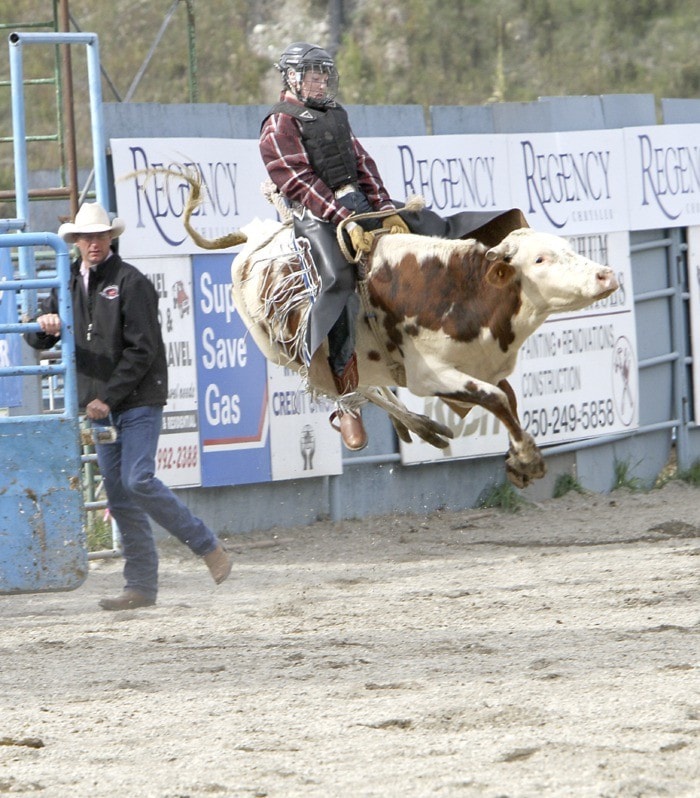Alex Fraser Park was unexpectedly quiet last weekend.
There was no whoopin’ and hollerin’ and certainly no smiles.
The empty corrals stood as a testament to the respect local organizers, the British Columbia Rodeo Association and the British Columbia High School Rodeo Association accord the recent appearance of Equine herpesvirus type 1 in B. C. and Alberta.
In addition to hosting a leg of the high school rodeo, the weekend was scheduled to serve as the finals for the Wrangler Rodeo series, with the athletes from Grades 6 – 8 competing for a spot at the National High School Rodeo Association Junior High Division finals held in Gallup, New Mexico.
Participants were coming from Fort St. John and all points south in the interior, BCRA member Darla Cork said.
But that all changed May 16 when Cork and other organizers received word a few cases of EHV-1 had been confirmed in Alberta and there were several suspected cases in B.C.
“This is a precautionary and proactive measure to protect our horses and help contain any spread of the contagious and potentially deadly virus,” president of the British Columbia High School Rodeo Association Sandy Chevallier said.
The cancellation of the rodeo kept more than 150 competitors home, Cork said.
“It’s a disappointment for the kids,” she acknowledged, including her son Lane, who has just begun to ride bulls with some measure of success after learning the ropes riding steers in the junior high school circuit.
“But we wanted everyone and our animals to be safe.”
EHV-1 can present itself in one of two forms.
The most common is respiratory disease, with affected horses presenting with fever, nasal discharge and coughing.
More severe cases can involve abortions or the infection of neonatal foals.
A second and more serious form of the EHV-1 virus is neurologic disease, nEHV-1, or Equine herpesvirus myeloencephalopathy.
In this instance the virus causes damage to the inner lining of blood vessels, including those of the blood-brain barrier.
Horses afflicted with nEHV-1 may experience fever and respiratory disease before showing signs of the neurologic form of EHV-1 which affects the hind limbs and the urinary system.
In such cases, horses may exhibit loss of co-ordination, urinary incontinence, sit like dogs, or simply lay down and not be able to get up again.
As of May 19, there were three horses in B.C. showing varying degrees of nEHV-1, but all were responding to treatment, Greg Andrews, DVM, said, speaking on behalf of equine veterinarians, provincial veterinarians and the Alberta Veterinary Medical Association.
In Alberta, the group reported, the number of infected horses may rise up to nine – 11, depending on the results of tests on a group of horses that attended a cutting horse competition in the first week of May in Utah, which seems to be the origin of the recent rash of EHV-1 infections in B.C. and Alberta.
Regardless of the outcome of the pending tests, the group of equine veterinarians, provincial veterinarians and the Alberta Veterinary Medical Association was optimistic the current EHV-1 infections had been contained.
“It is the opinion of this group of veterinarians the risk associated with attending a competition or event is very low at this time. This is because only one horse has been affected with the neurologic form in Alberta and currently there has been no “second wave” of infection,” Andrews said.
If infected, a horse will normally begin to display the symptoms anywhere from a couple of days up to two weeks later, but as late as 21 days later.
The Quesnel rodeo fell into that time frame, hence the precautionary cancellation.
With a second wave of infections likely averted, younger rodeo athletes will get to whoop and holler this weekend as the BCHSRA has rescheduled the Wrangler division rodeo for May 27 - 29, in Valemont.
At press time, both the College of Veterinarians of B.C. and the B.C. Ministry of Agriculture had
not issued press releases regarding EHV type-1 in British Columbia.
